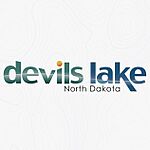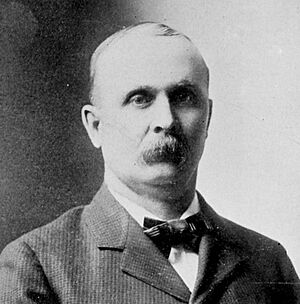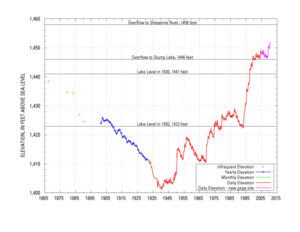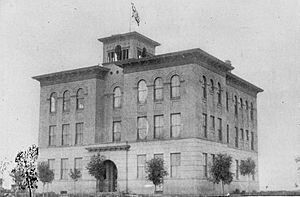Devils Lake, North Dakota facts for kids
Quick facts for kids
Devils Lake, North Dakota
|
||
|---|---|---|
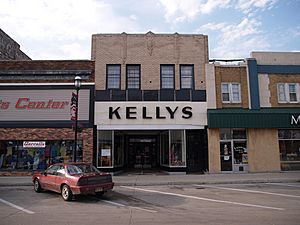
Downtown Devils Lake
|
||
|
||

Location of Devils Lake, North Dakota
|
||
| Country | United States | |
| State | North Dakota | |
| County | Ramsey | |
| Founded | 1882 | |
| Incorporated (village) | 1884 | |
| Incorporated (city) | 1887 | |
| Area | ||
| • City | 6.965 sq mi (18.039 km2) | |
| • Land | 6.959 sq mi (18.023 km2) | |
| • Water | 0.006 sq mi (0.015 km2) | |
| Elevation | 1,437 ft (438 m) | |
| Population
(2020)
|
||
| • City | 7,192 | |
| • Estimate
(2023)
|
7,135 | |
| • Density | 1,033.48/sq mi (399.04/km2) | |
| • Urban | 7,493 | |
| • Metro | 11,463 | |
| Time zone | UTC–6 (Central (CST)) | |
| • Summer (DST) | UTC–5 (CDT) | |
| ZIP Code |
58301
|
|
| Area code(s) | 701 | |
| FIPS code | 38-19420 | |
| GNIS feature ID | 1035989 | |
| Highways | US 2, ND 19, ND 20 | |
| Sales tax | 7.5% | |
Devils Lake is a city in North Dakota, United States. It is the main city in Ramsey County. In 2020, about 7,192 people lived there. The city gets its name from a large lake nearby, also called Devils Lake.
The first house built by European-American settlers in the area was in 1882. A surveyor named Heber M. Creel mapped out the town in 1883. It was first called Creelsburg, then Creel City, after him. In 1884, the name was changed to Devils Lake.
The local newspaper is the Devils Lake Journal. The city has its own airport, Devils Lake Municipal Airport. Devils Lake is also home to Lake Region State College and the North Dakota School for the Deaf.
Contents
Discovering Devils Lake's Past
How Devils Lake Got Its Name
The land where Devils Lake now stands was once home to the Dakota people. They called the nearby lake mni wak’áŋ. This means "spirit water" or "sacred water."
When European-American settlers arrived, they misunderstood the name. They thought mni wak’áŋ meant "Bad Spirit Lake" or "Devils Lake." The "bad" part referred to the lake's salty water, which was not good for drinking. The "spirit" part was about the mirages often seen over the water. The idea of a "devil" was not part of the Dakota people's beliefs.
The Hidatsa people also had a name for the lake: mirixubaash, which means "sacred water."
Early Days of the City
The first post office in the area opened on November 15, 1882. It was first called Creelsburg. Lieutenant Heber M. Creel started it. He was a surveyor who had worked at Fort Totten nearby. After leaving the army, he planned out the town.
The area around the city, Creel Township, is named after Mr. Creel. The town's name later changed to Creel City. Then, when it became an official village in 1884, it was named the City of Devils Lake. Later, it was simply called Devils Lake.
Rising Waters of the Lake
Starting in the 1990s, there was a lot more rainfall than usual. This caused the nearby lake to rise a lot. The lake has no natural way for water to flow out. Because of the rising water, the lake's size has become four times bigger. More than 400 houses have had to be moved or were destroyed by the water.
Geography and Climate of Devils Lake
Where is Devils Lake Located?
The city of Devils Lake covers about 6.965 square miles (18.039 square kilometers). Most of this area is land, with a very small part being water.
Understanding the Weather
Devils Lake has a climate with very cold winters and warm, wet summers. In winter, it often snows lightly. Temperatures can drop below 0°F (–18°C) on many nights. It stays below freezing for over 100 days a year. Sometimes, months can pass without the temperature rising above freezing.
Summers are warm, and most rain comes from thunderstorms. It rarely gets extremely hot. Temperatures usually do not reach 100°F (38°C).
| Climate data for Devils Lake, North Dakota (1971–2000, extremes 1948–2001) | |||||||||||||
|---|---|---|---|---|---|---|---|---|---|---|---|---|---|
| Month | Jan | Feb | Mar | Apr | May | Jun | Jul | Aug | Sep | Oct | Nov | Dec | Year |
| Record high °F (°C) | 53 (12) |
60 (16) |
72 (22) |
97 (36) |
96 (36) |
103 (39) |
103 (39) |
103 (39) |
100 (38) |
94 (34) |
77 (25) |
59 (15) |
103 (39) |
| Mean daily maximum °F (°C) | 14.7 (−9.6) |
22.3 (−5.4) |
33.6 (0.9) |
52.1 (11.2) |
67.5 (19.7) |
75.3 (24.1) |
80.1 (26.7) |
79.1 (26.2) |
67.7 (19.8) |
53.9 (12.2) |
33.1 (0.6) |
19.4 (−7.0) |
49.9 (9.9) |
| Mean daily minimum °F (°C) | −2.5 (−19.2) |
5.2 (−14.9) |
17.3 (−8.2) |
32.2 (0.1) |
44.9 (7.2) |
54.3 (12.4) |
58.6 (14.8) |
56.2 (13.4) |
46.5 (8.1) |
34.6 (1.4) |
18.4 (−7.6) |
3.6 (−15.8) |
30.8 (−0.7) |
| Record low °F (°C) | −36 (−38) |
−37 (−38) |
−28 (−33) |
−12 (−24) |
1 (−17) |
29 (−2) |
39 (4) |
33 (1) |
20 (−7) |
−2 (−19) |
−25 (−32) |
−37 (−38) |
−37 (−38) |
| Average precipitation inches (mm) | 0.58 (15) |
0.51 (13) |
0.80 (20) |
0.90 (23) |
2.14 (54) |
3.83 (97) |
3.29 (84) |
2.21 (56) |
1.80 (46) |
1.47 (37) |
0.83 (21) |
0.57 (14) |
18.93 (480) |
| Average snowfall inches (cm) | 6.3 (16) |
4.7 (12) |
6.3 (16) |
2.2 (5.6) |
0.3 (0.76) |
0.0 (0.0) |
0.0 (0.0) |
0.0 (0.0) |
0.0 (0.0) |
1.9 (4.8) |
5.4 (14) |
7.2 (18) |
34.3 (87.16) |
| Average precipitation days (≥ 0.01 inch) | 8.4 | 6.7 | 7.2 | 7.1 | 9.5 | 12.1 | 10.1 | 8.9 | 8.4 | 7.3 | 6.8 | 7.4 | 99.9 |
| Average snowy days (≥ 0.1 inch) | 6.2 | 3.7 | 3.8 | 1.1 | 0.1 | 0.0 | 0.0 | 0.0 | 0.1 | 0.7 | 3.1 | 4.8 | 23.6 |
| Source: NOAA | |||||||||||||
People of Devils Lake
Population Changes Over Time
| Historical population | |||
|---|---|---|---|
| Census | Pop. | %± | |
| 1890 | 846 | — | |
| 1900 | 1,729 | 104.4% | |
| 1910 | 5,157 | 198.3% | |
| 1920 | 5,140 | −0.3% | |
| 1930 | 5,451 | 6.1% | |
| 1940 | 6,204 | 13.8% | |
| 1950 | 6,427 | 3.6% | |
| 1960 | 6,299 | −2.0% | |
| 1970 | 7,078 | 12.4% | |
| 1980 | 7,442 | 5.1% | |
| 1990 | 7,782 | 4.6% | |
| 2000 | 7,222 | −7.2% | |
| 2010 | 7,141 | −1.1% | |
| 2020 | 7,192 | 0.7% | |
| 2023 (est.) | 7,135 | −0.1% | |
| U.S. Decennial Census 2020 Census |
|||
Who Lives in Devils Lake?
| Race | Number | Percent |
|---|---|---|
| White (NH) | 5,331 | 74.1% |
| Black or African American (NH) | 58 | 0.8% |
| Native American (NH) | 1,148 | 16.0% |
| Asian (NH) | 55 | 0.8% |
| Pacific Islander (NH) | 6 | 0.1% |
| Some Other Race (NH) | 2 | 0.0% |
| Mixed/Multi-Racial (NH) | 395 | 5.5% |
| Hispanic or Latino | 197 | 2.7% |
| Total | 7,192 | 100.0% |
In 2020, there were 7,192 people living in Devils Lake. There were about 3,202 households. Most people were White (74.1%). About 16% were Native American.
About 23.6% of residents were under 18 years old. About 22.5% were 65 years or older.
Learning and Education
Schools for All Ages
The city of Devils Lake has its own public school system. This includes Sweetwater Elementary, Prairie View Elementary, and Minnie H Elementary schools. There is also Central Middle School and Devils Lake High School.
A private school, St. Joseph's Catholic School, is also in Devils Lake.
Colleges and Higher Learning
For students who want to continue their education, Lake Region State College is located in Devils Lake.
Sports and Recreation
Devils Lake has local sports teams. These include the Devils Lake Storm baseball team and the Devils Lake Firebirds. Students at Lake Region State College can also play for the Royals teams in the NJCAA.
News and Entertainment
Local News
The main newspaper for the city is the Devils Lake Journal.
TV and Radio Stations
Devils Lake has several TV channels. WDAZ-TV (Channel 8) is linked to ABC. KMDE (Channel 25) offers PBS programs.
There are also many radio stations. These include Christian, tribal, public, and music stations. You can find classic country, hot adult contemporary, and classic hits music.
Getting Around Devils Lake
Train and Air Travel
Amtrak, the national passenger train system, serves Devils Lake. The Empire Builder train stops here daily. It travels between Chicago and cities like Seattle and Portland.
SkyWest Air Lines offers two flights daily from the Devils Lake Municipal Airport. These flights connect to Denver International Airport.
Local Transportation
Devils Lake Transit provides local transportation. It's a "dial-a-ride" service. This means you can call to arrange a ride. It operates on weekdays from 7:35 AM to 5:00 PM.
Places to Visit
- Devils Lake Town and Country Club
Notable People from Devils Lake
Many interesting people have come from Devils Lake:
- Phyllis Frelich: A famous deaf actress who won a Tony Award.
- William L. Guy: A former Governor of North Dakota.
- Rick Helling: A pitcher who played for several Major League Baseball teams.
- Ralph Maxwell: A state court judge and athlete.
- Grant Nelson: A basketball player for the Alabama Crimson Tide.
- Mary Wakefield: An Administrator for Health Resources and Services Administration.
- Owen Webster: A chemist who studied organic and polymer materials.
Images for kids
See also
 In Spanish: Devils Lake (Dakota del Norte) para niños
In Spanish: Devils Lake (Dakota del Norte) para niños


